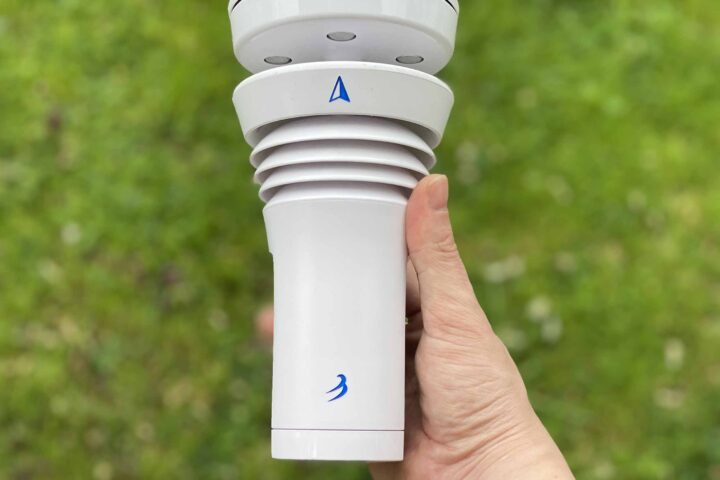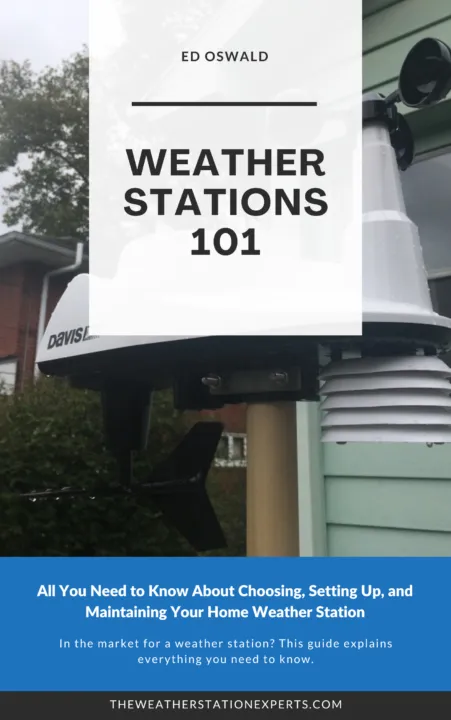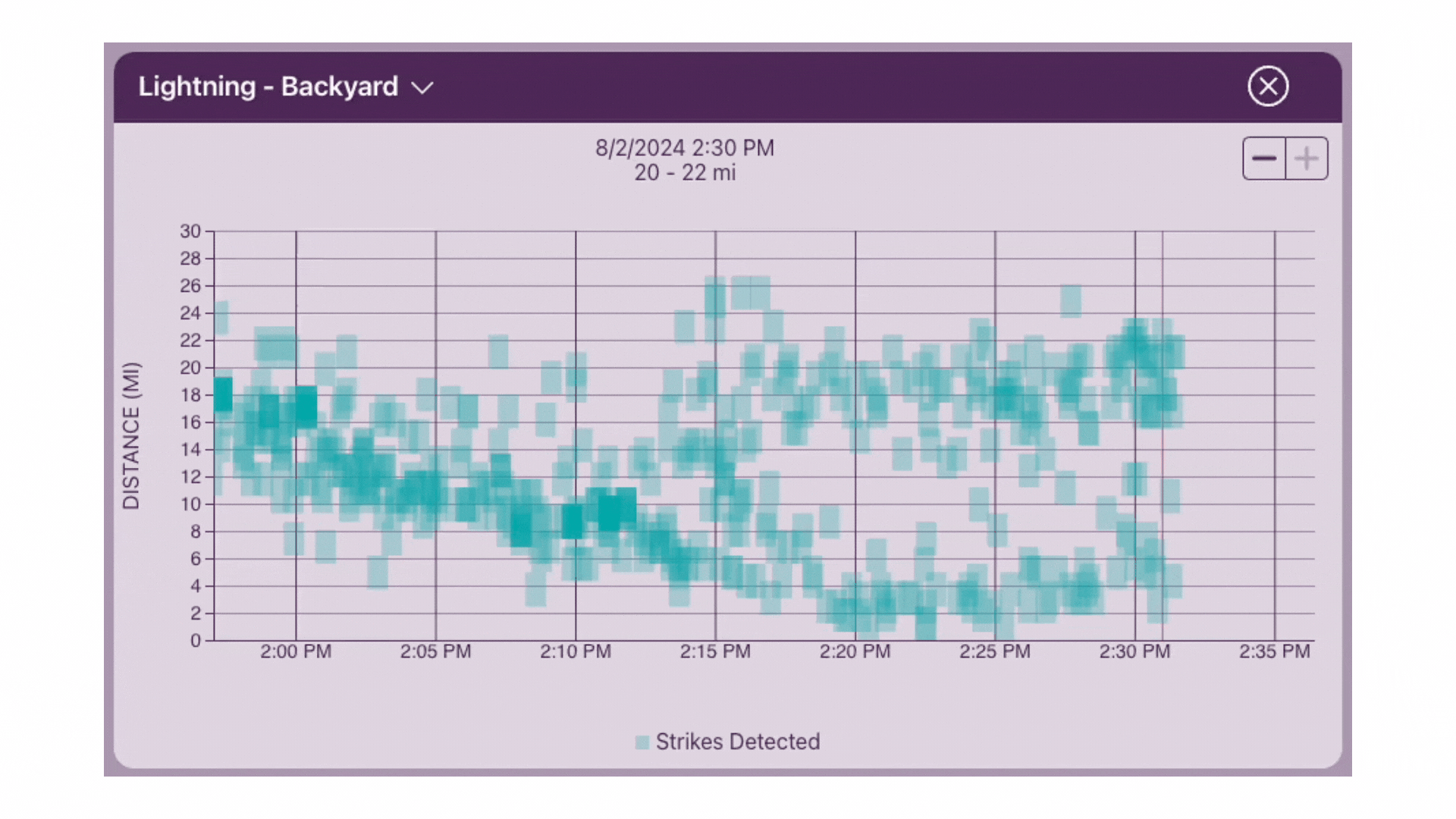- Super quick setup
- Outstanding lightning detection
- Fairly accurate instrumentation
- Ready for the smart home
- The haptic rain sensor doesn’t measure rainfall accurately enough
- No expandability
Date of our Original Review: June 2020
Date of Current Review: July-August 2024
For nearly the entire time that the Weather Station Experts have existed, the Tempest Weather System (formerly the WeatherFlow Tempest) has been our top pick. And there’s a reason Since its debut in 2020, it has become one of the most popular home weather stations on the market thanks to its easy installation, great feature set, and smart home connectivity.
While not “cheap,” a $339 retail puts it in the mid-range of home weather stations. The Tempest includes all the basics plus UV and solar, outstanding lightning detection, and a haptic rain sensor that at launch was a first for home weather stations, and was recently copied by Ecowitt for its Wittboy all-in-one.
I originally reviewed the Tempest elsewhere in 2020 and reposted the review here in 2021. But it’s been more than three years. That’s a lifetime in tech, so this summer, we set out to re-review the Tempest Weather System.
Unfortunately, time had done a number on our launch model Tempest internal battery, which no longer would take a charge. Tempest sent us a new unit, which we’re using for the review here (within days of our support request, too!). From the outside, all the equipment looks identical.
In our original review, we loved everything but the haptic rain sensor. Has anything changed in our thinking? Keep reading.
(Editor’s note: WeatherFlow spun off its weather station unit into a separate company, called Tempest. The name of the WeatherFlow Tempest is now the Tempest Weather System and is how we will refer to the station here on TWSE.)
Setting up the Tempest Weather System
The installation of the Tempest remains its strong point, and if anything, has improved since we last tested the station in 2020. While most home weather stations require 30-60 minutes to install, you may have everything running and reporting in as little as five minutes if you already have a place to mount your station. You can mount it to the top of a mast or screw it onto just about anything using the tripod mount.
It’s surprisingly small and light at 7.25 inches by 7.25 inches by 12 inches and just 3.5 pounds, making the installation easy. As you can see from the picture, nearly the entire sensor fits in my hand. This compact design allows for a lot less clumsy installation — if you’ve installed a weather station before, you know the sensor suites are often bulky and hard to maneuver to install.
Since everything is pre-assembled, you place the included base station within range of your Wi-Fi router and the Tempest within range of the base station. To be safe we recommend less than 100 feet for the most reliable communication. You should start seeing data in your app within minutes. One tip, though: don’t forget to turn the sensor suite on! If you don’t do that first, the installation will fail.

Lots of functionality
There is no console with the Tempest: everything is handled through the app, and save for a color theme change from WeatherFlow’s sky blue to the purple shades that Tempest now uses, everything is the same. Data updates every three seconds even if you’re not on the same Wi-Fi. By a large margin, that’s faster than any other station: most update to the app in 60-second increments.
The Tempest reports temperature, humidity, wind speed and direction, and rainfall, and also includes a UV and light sensor and built-in lightning detection. Thanks to haptic technology, it can also sense precipitation intensity.
Data collected by your Tempest is sent to WeatherFlow, which is used to improve the accuracy of its local forecasts. It is also shared with the National Weather Service and others as well. As expected of a smart weather station, the Tempest supports Amazon Alexa and IFTTT. We did notice that support for Google Home (formally Google Assistant) is no longer available, a change from integrations available at launch.

From our understanding, this is due to Google ending support for the methods Tempest used to connect to Assistant. It appears the change is significant enough that it requires significant changes to the platform itself, which at least for the moment Tempest developers do not plan on correcting.
Google Home is used by roughly a quarter of all smart speaker users, so this may be a significant issue for some. It’s enough to have an impact on our scoring metrics, as other platforms have not had the same issue and still offer Google Home support.

Buying a weather station? No clue where to start?
We can help. Our 40-page book contains tips to help you choose, understand, and maintain your weather station. All proceeds go to help us make more videos!
Buy NowTempest Weather System Accuracy and Performance
While launch units did have issues with calibration, our reviews of the experiences of recent reviews seem to suggest that’s no longer an issue. The station is supposed to self-calibrate, so you should not have to make any changes if you followed the setup correctly.
Data reports anywhere from two to 30 seconds, depending on the sensor. In our previous test in 2020, we found that overall, the readings from all sensors were within acceptable ranges (although humidity readings sometimes felt a bit on the high side), but the haptic rain gauge struggled (we consider temperatures within two degrees, humidity within 5%, barometric pressure within .05″, and rainfall within .02″ of an inch “acceptable” — we don’t include wind due to most home weather stations location is not at the proper height).
The Tempest also includes lightning detection as well, but that’s so good it deserves a separate section (hint: keep reading).
In the re-review, we wanted to focus on whether the haptic rain gauge had improved. We loved the sensitivity, and how quickly the Tempest informed us that it had detected rain, often within seconds. This is perfect for smart home applications, especially smart home sprinkler systems. However, we were much less impressed with its accuracy in measuring rainfall.
The “Rain Check” feature remains, now called NearCast Rain. It seems to function a bit differently than Rain Check, though. I don’t remember Rain Check in 2020 adjusting measured rainfall in real-time; instead, the adjustment happened overnight. Here it seems to be continuously occurring. However, I question whether it is really necessary.
In 2020, the Tempest was under measuring rainfall whether the feature was on or off. To our surprise in our 2024 test, with NC Rain off, in extremely heavy rain the measured rainfall was within .05″ of our KestrelMet 6000. Previously, the differences were measured in tenths. Keeping NC Rain on actually made the Tempest much less accurate, the complete opposite of our previous experience. We’d need to watch this over time, but this is a significant improvement and led to a slight adjustment upward in the Tempest’s overall score.
Years ago, the Rain Check adjustment was needed because the haptic rain gauge just wasn’t working well. Now it may be working against it. While this may have some use to WeatherFlow for their forecast models, it isn’t a real measurement — rain is measured at the point of the gauge. We’re just not fans of the idea at all.
Read more: How to make your Tempest Weather System rain gauge more accurate
It still has the best lightning detection we’ve seen
So we told you to keep reading because the lightning detection is just that good. It is. Over the past decade, we’ve tested many lightning detection options from various manufacturers. We’ve seen it all, including some that felt like you’d have a better idea of incoming storms if you listened to static on AM radio.
That is not the case here at all. Both during our initial test and our re-review, the Tempest detected lightning strikes quicker and more accurately than any other system we’ve tested. We use lightningmaps.org during storms to verify strike data. Numbers were very close to what our Tempest saw, and distance detection was fairly accurate.
For fun, we tried to use IFTTT to light up our Nanoleaf Panels for each lightning strike, but unfortunately, it looks like it’s rate-limited to once a minute, either on IFTTT or Tempest’s end. Would have been cool during the line of thunderstorms in near real-time flashing on our Nanoleafs, but it was not to be.

The Tempest Weather System has gotten better, for sure.
We were bummed about the performance of the haptic rain sensor in our original review and were perhaps the loudest in our criticism of it. However, we are happy to say that things have gotten much better. Lightning detection remains the top reason we keep it as our Editor’s Choice — there is no comparison in terms of performance with any other weather station.
Sure the lack of Google Home support is a real pain for those in the Google ecosystem, but overall the smart home capabilities remain robust. At $339, it is also not a bad deal considering most decent home weather stations these days average around $500 or more. If you can not afford a pro-grade home weather station, the Tempest is probably your best bet.
Tempest Weather System

With exceptional lightning detection and fairly accurate instrumentation, the Tempest Weather System impresses for smart home readiness.
Product Brand: Tempest
4.7
Pros
- Super quick setup
- Outstanding lightning detection
- Fairly accurate instrumentation
- Ready for the smart home
Cons
- Haptic rain sensor doesn't measure rainfall accurately enough
- No expandability



